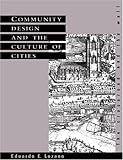Community design and the culture of cities : the crossroad and the wall / Eduardo E. Lozano.
Material type: TextPublication details: Cambridge ; New York : Cambridge University Press, 1990.Description: xiii, 340 p. : ill. ; 27 cmISBN:
TextPublication details: Cambridge ; New York : Cambridge University Press, 1990.Description: xiii, 340 p. : ill. ; 27 cmISBN: - 0521380677
- 9780521389792
- 0521389798 (pbk.)
- 307.1216 20
- HT166 .L69 1990
| Item type | Current library | Call number | Status | Date due | Barcode | |
|---|---|---|---|---|---|---|
 Books
Books
|
Main library | 307.1216/ LE.C (Browse shelf(Opens below)) | Not For Loan | 015503 |
Browsing Main library shelves Close shelf browser (Hides shelf browser)
| No cover image available No cover image available |

|

|

|

|
No cover image available No cover image available | No cover image available No cover image available | ||
| 307 / EA.T 2010 تاريخ المستقبل | 307.12/DO.T Time-saver standards for urban design / | 307.12 / WA.T 2003 Time-saver standards for urban design / | 307.1216/ LE.C Community design and the culture of cities : the crossroad and the wall / | 307.12160973 / LE.C 2009 Contemporary urban planning / | 307.14 / KH.M 2007 المجتمع المدنبي والدولة | 307.14091724 / RO. M 2004 من الحداثة إلى العولمة |
Includes bibliographical references and index.
Having perceived a widespread failure of most community-scale plans, Eduardo Lozano has created a large and humane vision for community design, geared toward urban planners and designers, as well as those concerned with the communities of the future. Lozano strives to unify theory and practice, seeing that design at community scale is a relatively new responsibility for professionals and seeing the need for an awareness of the systemic nature of urban design. He also highlights relevant lessons from historical examples in order to rediscover the community design metier forgotten after the industrial revolution. The author relies on interdisciplinary studies, drawing from biology, ecology, and political science, as well as from history for his fascinating study. Throughout the book there is an emphasis on the interrelationship of design and culture--society, technology, institutions, and values--and on the need for an agenda for political and cultural change
There are no comments on this title.
